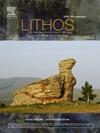Subduction initiation of the Neotethyan Ocean recorded in chromite deposits: A case study of the Kızıldağ ophiolite, southern Türkiye
IF 2.9
2区 地球科学
Q2 GEOCHEMISTRY & GEOPHYSICS
引用次数: 0
Abstract
The chromitites of the Kızıldağ ophiolite (KO) are primarily characterized by massive and disseminated textures within refractory mantle peridotites, predominantly harzburgite and dunite, with occasional occurrences of banded and nodular chromitites. Based on chromite composition, these chromitites can be classified into two groups exhibiting a broad compositional range: intermediate (0.55 ≤ Cr# < 0.70, TiO2 = 0.08–0.51 wt%) and high-Cr (0.70 ≤ Cr# ≤ 0.77, TiO2 = 0.05–0.28 wt%). The compositions of minor and trace elements align consistently with variations in Cr#. Total PGE (Os, Ir, Ru, Rh, Pt, Pd) contents in these chromitites are generally less than 500 ppb, with many samples showing enrichment of IPGE (Os, Ir, Ru) relative to PPGE (Rh, Pt, Pd). However, certain samples from both groups display elevated PGE concentrations (ƩPGEintermediate = 718 ppb, ƩPGEHigh-Cr = 866 ppb) compared to other samples. The dominant platinum group mineral inclusions in chromite are Ru-rich laurite [(Ru, Os)S2], with a single osmiridium (Os-Ir alloy) grain also observed suggesting formation under high-temperature and low ƒS2 conditions. Primary base metal mineral inclusions include millerite and pentlandite. Additionally, some chromite crystals contain single or multi-phase silicate inclusions, such as clinopyroxene, orthopyroxene, olivine, and amphibole. Parental melt compositions, calculated from Al2O3 and TiO2 contents of chromites, indicate that most high-Cr chromitites originated from boninitic melts, whereas intermediate chromitites and some high-Cr samples derived from melts with intermediate compositions. Trace element compositions of amphibole and clinopyroxene inclusions in the chromite crystals from the intermediate group further support crystallization from hydrous intermediate melts. It is proposed that the intermediate chromitite group formed from partial melts influenced by fluids from the subducted oceanic crust during the early stages of subduction initiation, while high-Cr chromitites originated from hydrous melts derived from a more depleted mantle wedge in later stages.
铬铁矿沉积中记录的新特提斯洋俯冲起始:以 rkiye南部Kızıldağ蛇绿岩为例
Kızıldağ蛇绿岩(KO)的铬铁矿主要呈块状和浸染状结构,分布在难熔地幔橄榄岩中,主要为辉锌矿和暗锰矿,偶见带状和结节状铬铁矿。根据铬铁矿组成,这些铬铁矿可分为两类,其组成范围较广:中间(0.55≤Cr# <;0.70、二氧化钛= 0.08 - -0.51 wt %)和高铬(0.70≤Cr #≤0.77,二氧化钛= 0.05 - -0.28 wt %)。微量元素和微量元素的组成与Cr#的变化一致。这些铬铁矿中总PGE (Os, Ir, Ru, Rh, Pt, Pd)含量一般小于500 ppb,许多样品显示IPGE (Os, Ir, Ru)相对于PPGE (Rh, Pt, Pd)富集。然而,与其他样品相比,来自两组的某些样品显示PGE浓度升高(ƩPGEintermediate = 718 ppb, ƩPGEHigh-Cr = 866 ppb)。铬铁矿中主要的铂族矿物包裹体为富钌的褐铁矿[(Ru, Os)S2],还观察到单一的锇(Os- ir合金)晶粒,表明其形成于高温和低ƒS2条件下。原生贱金属矿物包裹体包括千粒石和戊粒石。此外,一些铬铁矿晶体含有单相或多相硅酸盐包裹体,如斜辉石、正辉石、橄榄石和角闪石。根据铬铁矿的Al2O3和TiO2含量计算出的亲本熔体成分表明,大多数高铬铬铁矿来源于硼质熔体,而中间铬铁矿和部分高铬样品来源于中间成分的熔体。中间组铬铁矿晶体中角闪孔和斜辉石包裹体的微量元素组成进一步支持含水中间熔体的结晶。认为中铬铁矿群形成于俯冲起始早期受洋壳流体影响的部分熔体,而高铬铬铁矿形成于俯冲起始后期更为衰竭的地幔楔的含水熔体。
本文章由计算机程序翻译,如有差异,请以英文原文为准。
求助全文
约1分钟内获得全文
求助全文
来源期刊

Lithos
地学-地球化学与地球物理
CiteScore
6.80
自引率
11.40%
发文量
286
审稿时长
3.5 months
期刊介绍:
Lithos publishes original research papers on the petrology, geochemistry and petrogenesis of igneous and metamorphic rocks. Papers on mineralogy/mineral physics related to petrology and petrogenetic problems are also welcomed.
 求助内容:
求助内容: 应助结果提醒方式:
应助结果提醒方式:


